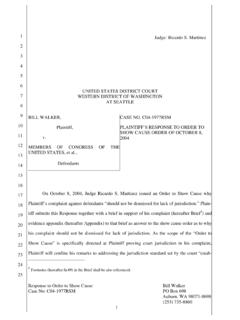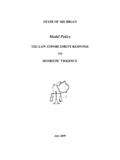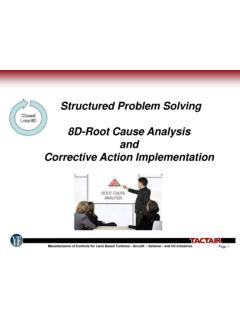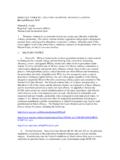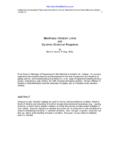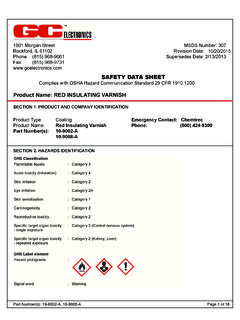Transcription of A study on tolerable waiting time: how long are …
1 1 a study on tolerable waiting time : how long are Web users willing to wait? Citation: Nah, F. (2004), a study on tolerable waiting time : how long are Web users willing to wait? Behaviour & Information Technology, forthcoming Fiona Fui-Hoon Nah College of Business Administration University of Nebraska-Lincoln Lincoln, Nebraska 68588-0491 USA Tel: (402) 472-6060 Fax: (402) 472-5855 Email: Abstract Web users often face a long waiting time for downloading Web pages. Although various technologies and techniques have been implemented to alleviate the situation and to comfort the impatient users, little research has been done to assess what constitutes an acceptable and tolerable waiting time for Web users. This research reviews the literature on computer response time and users waiting time for download of Web pages, and assesses Web users tolerable waiting time in information retrieval.
2 It addresses the following questions through an experimental study : What is the effect of feedback on users tolerable waiting time ? How long are users willing to wait for a Web page to be downloaded before abandoning it? The results from this study suggest that the presence of feedback prolongs Web users tolerable waiting time and the tolerable waiting time for information retrieval is approximately 2 seconds. 2 1. Introduction The World Wide Web (WWW) has become an important channel for information retrieval, electronic commerce and entertainment. However, long Web page download times have remained a major cause of frustration among Web users (Selvidge 1999, 2003). According to the findings of the surveys conducted by Lightner, Bose and Salvendy (1996) and the GVU (Graphic, Visualization and Usability) Centre at Georgia Institute of Technology (GVU, 1998), long download times have always been a major problem experienced by Web users.
3 The survey by Pitkow and Kehoe (1996) also indicates that the most widely cited problem with using the WWW was that it took too long to download Web pages ( 69% of respondents cited this problem). This problem is worsened by the exponential increase in the number of Web users over the years and the popularity of multimedia ( video, voice) technology. This problem is so noticeable that Web users often equate the WWW acronym with World Wide Wait ! The WWW has become an important and popular information search tool. It provides convenient access to almost all kinds of information from education to entertainment. It also makes global information available at our fingertips. Although the WWW is now accessible from mobile devices, usage and adoption rates are low due to the long download time and limited bandwidth available in the wireless environment.
4 As noted earlier, the long waiting time for downloading Web pages is often not tolerable even in the wired environment. Due to the increasing and excessive use of multimedia data ( audio and video clips) on Web pages, this concern is continuously growing. This problem of long download time is relevant not only to Web users but also to the authors and designers of websites, as websites that take a long time to download are rarely or less frequently visited (Reaux and Carroll 1997). Hence, it is important for us to gain a more in-depth understanding of Web users waiting behaviour. More specifically, the main questions of interest are: How long are users willing to wait for downloading a Web page before abandoning it? We will refer to this duration as the tolerable waiting time (TWT).
5 Does providing feedback during the wait prolong Web users tolerable waiting time ? 3 The answers to the above questions are important for making decisions on hardware and software investments as well as Web page design and contents in order to provide acceptable download time to users. Network providers and website designers make such decisions based on their understanding of what constitutes an acceptable download time . Since the types of task ( information retrieval, browsing, purchasing, downloading of files) may have an impact on users level of tolerance, we will examine information retrieval task in this research, which is one of the most common tasks on the WWW. The rest of this paper is organized as follows: The next section reviews the literature on users TWT and formulates the hypothesis concerning the effect of feedback on Web users TWT.
6 Section 3 describes an experimental study to answer the questions in this research. The results of the study are reported in Section 4. Section 5 concludes with implications of the research and discussions for future research. 2. Literature on waiting time According to Nielsen (1999: 67), download speeds are the single-most important design criterion on the Web . Web users are constantly begging for faster page downloads (Nielsen 2000). Although long download time of Web pages has been a consistent problem encountered by Web users (Lightner et al. 1996, Pitkow and Kehoe 1996, Selvidge 1999, 2003), it is still controversial as to what constitutes an acceptable waiting time for a typical Web page download (Bailey 2001). Nielsen (1997) advocates the 10-second limit, while Zona Research (1999) recommends the 8-second rule.
7 Selvidge s (1999) study shows that there is no difference in users frustration levels between 1-second and 20-second delay, but a difference (with 1-second delay) was observed at 30-second delay. Other researchers propose the 2-second rule (Shneiderman 1984) and the 12-second rule (Hoxmeier and DiCesare 2000). The conflicting evidence in the literature was also highlighted and examined by Galletta, Henry, McCoy and Polak (2002), who observed decreases in performance and behavioural intentions at 4 seconds. 4 Interestingly and ironically, the average American users that use dial-up connections wait about 30 seconds the first time they look at a new Web page (Chen 2002)! Web page download time is affected by the performance of the browser, the speed of the Internet connection, the local network traffic, the load on the remote host, and the structure and format of the Web page requested.
8 In this research, we are not addressing the issue of how these different variables can be balanced or traded-off to produce an acceptable download time but rather, we are interested in finding out what constitutes an acceptable or, more exactly, tolerable download time for a typical Web user. Although acceptable or tolerable waiting time for Web page download can be defined from various perspectives ( change in attitudes such as satisfaction or frustration, behavioural intentions such as intention to visit or not visit the site again, perceptions such as perceived waiting time , performance such as quality or accuracy, or user behaviour such as the act of abandoning a Web page), in this research, tolerable waiting time (TWT for short) is defined as the amount of time users are willing to wait before giving up on the download of a Web page.
9 tolerable computer response time This section reviews earlier research on computer response times where it is suggested that (Nielsen 1993): (1) second is about the limit for having the user feel that the system is reacting instantaneously, meaning that no special feedback is necessary except to display the result. (2) second is about the limit for the user s flow of thought to stay uninterrupted, even though the user will notice the delay. Normally, no special feedback is necessary during delays of more than but less than second, but the user does lose the feeling of operating directly on the data. (3) 10 seconds is about the limit for keeping the user s attention focused on the dialogue.
10 For longer delays, users will want to perform other tasks while waiting for the computer to finish, so they should be given feedback indicating when the computer expects to be done. 5 Table 1 provides a summary of the literature on users tolerance in waiting for computer response. Miller (1968) argued for the 2-second rule based on the theory of limitations in human short-term memory. According to Miller, short-term memory plays a critical role in human information processing; interference with short-term memory can occur when an individual senses an awareness of waiting after approximately 2 seconds. Thus, to stay uninterrupted in information processing, the 2-second guideline is recommended. For tasks where uninterrupted focus is critical, Nielsen (1995) suggests that computer response should be kept within one second.
